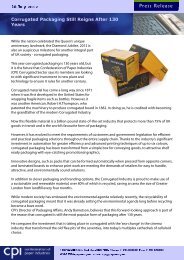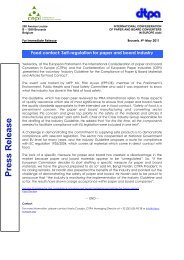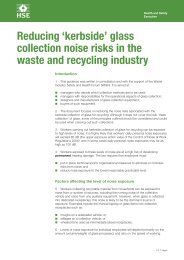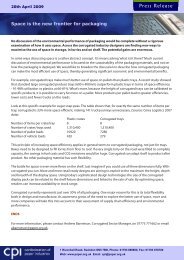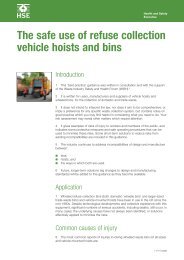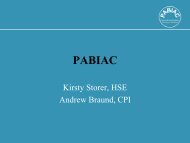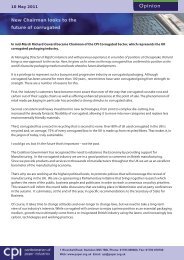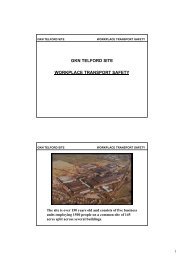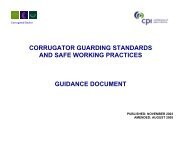Updated Notes on Risk Assessment for Hand- Fed Platen Presses
Updated Notes on Risk Assessment for Hand- Fed Platen Presses
Updated Notes on Risk Assessment for Hand- Fed Platen Presses
Create successful ePaper yourself
Turn your PDF publications into a flip-book with our unique Google optimized e-Paper software.
October 2008<br />
<str<strong>on</strong>g>Updated</str<strong>on</strong>g> <str<strong>on</strong>g>Notes</str<strong>on</strong>g> <strong>on</strong> <strong>Risk</strong> <strong>Assessment</strong> <strong>for</strong> <strong>Hand</strong>- <strong>Fed</strong> <strong>Platen</strong> <strong>Presses</strong><br />
Introducti<strong>on</strong><br />
These notes should be read in c<strong>on</strong>juncti<strong>on</strong> with the Corrugated Packaging Associati<strong>on</strong> Recommended Safety<br />
Specificati<strong>on</strong> <strong>for</strong> <strong>Hand</strong>-<strong>Fed</strong> <strong>Platen</strong> <strong>Presses</strong> (March 2002), available from The C<strong>on</strong>federati<strong>on</strong> of Paper Industries<br />
(CPI) http://www.paper.org.uk/services/health_safety/machinery_safety.html<br />
Fatal Accidents 2007-2008<br />
We are aware of 4 fatal accidents that have occurred <strong>on</strong> hand-fed platen presses between 2007 and 2008.<br />
• Two accidents occurred in the UK <strong>on</strong> machines fitted with c<strong>on</strong>venti<strong>on</strong>al safeguarding i.e. a U-shaped<br />
trip bar; pressure sensitive fr<strong>on</strong>t edge of the moving platen; and side tables.<br />
• The third accident occurred in Germany <strong>on</strong> a machine fitted with 3 laser scanners designed to protect a<br />
pers<strong>on</strong> gaining access to the danger z<strong>on</strong>e i.e. the space between the fixed and moving platen.<br />
• The <strong>for</strong>th occurred in Cali<strong>for</strong>nia and no significant details are yet available.<br />
These recent fatalities clearly dem<strong>on</strong>strate the high risk that these machines pose to operators.<br />
Accident reports <strong>for</strong> UK and Europe<br />
There were a number of similarities between the 3 accidents:<br />
• All the machines involved in the accidents were being operated in dwell mode (2.5 sec, 3.5 sec and 6<br />
sec respectively);<br />
• All the machines involved in the accidents were of the medium/large <strong>for</strong>mat size where whole body<br />
access <strong>on</strong>to the bed of the lower platen was not <strong>on</strong>ly possible, but also necessary to carry out an<br />
interventi<strong>on</strong> such as, to clear a mis-feed.<br />
• In each accident, it appears that the operative climbed <strong>on</strong>to the bed of the lower (movable) platen and<br />
then the dwell cycle operated, crushing the operator between the two platens.<br />
Identified High <strong>Risk</strong> Situati<strong>on</strong>s<br />
Large/Medium Format Machines - where whole body access is needed <strong>on</strong>to the bed of the <strong>Platen</strong><br />
The larger that hand-fed platen presses become, the more likely operators will need to gain whole body<br />
access/interventi<strong>on</strong> <strong>on</strong>to the bed of the platen. When these larger machines are used in c<strong>on</strong>juncti<strong>on</strong> with the<br />
dwell facility, this creates a high risk crushing situati<strong>on</strong> from the hazard z<strong>on</strong>e between the two platens.<br />
C<strong>on</strong>trol Measures<br />
Managing the <strong>Risk</strong><br />
The first step in determining c<strong>on</strong>trol measures is to c<strong>on</strong>sider the opti<strong>on</strong> of eliminating the hazard, which in this<br />
case means, c<strong>on</strong>sidering if the machine is essential <strong>for</strong> the business. It may be possible to c<strong>on</strong>clude that the<br />
machine is used infrequently and that there is a safer producti<strong>on</strong> method that does not adversely affect the<br />
business. If you cannot eliminate the hazard, then the risks must be c<strong>on</strong>trolled by other means.<br />
To manage the risks effectively, employers will need:<br />
• Safeguards to prevent access when the press is operating. This can be a difficult situati<strong>on</strong> <strong>on</strong> larger<br />
machines that may require technically complex soluti<strong>on</strong>s that allow normal operati<strong>on</strong> whilst also<br />
providing a safe working envir<strong>on</strong>ment <strong>for</strong> machine operatives. In c<strong>on</strong>juncti<strong>on</strong> with these safeguards<br />
there will need to be:<br />
• Safe systems of work<br />
• Robust regime of workplace inspecti<strong>on</strong> and maintenance to ensure safeguards are working correctly<br />
• Training and supervisi<strong>on</strong><br />
• M<strong>on</strong>itoring and review ensuring that all c<strong>on</strong>trols are being effectively implemented<br />
<str<strong>on</strong>g>Notes</str<strong>on</strong>g>: Employers should not rely solely <strong>on</strong> the physical safeguards al<strong>on</strong>e.<br />
The HSE issued a safety alert which covers these points in more detail. http://www.hse.gov.uk/printing/alert.htm<br />
1
Managing the Dwell Facility<br />
<strong>Hand</strong>-fed platen presses have been around <strong>for</strong> a l<strong>on</strong>g time and the c<strong>on</strong>cept of dwell is well established. It is<br />
recognised that there may be str<strong>on</strong>g commercial reas<strong>on</strong>s to use the dwell facility to maximise productivity. It is<br />
recommended that the following comments be taken into c<strong>on</strong>siderati<strong>on</strong> when assessing the use of a dwell<br />
facility:<br />
• Possible eliminati<strong>on</strong> of the dwell facility. C<strong>on</strong>siderati<strong>on</strong> should be given to the removal of the dwell<br />
facility and whether it is practical to operate the machine <strong>on</strong>ly in manual (single stroke) or in automatic<br />
(c<strong>on</strong>tinuous run) mode.<br />
• Possible reducti<strong>on</strong> in the maximum length of the dwell cycle. The current EU Standard (defined in<br />
EN 10 -10 Part 5) specifies that, where a timer–c<strong>on</strong>trolled operati<strong>on</strong> or a ‘dwell’ device is fitted, the<br />
‘dwell’ period should not exceed 12 sec<strong>on</strong>ds. In the HSE Printers Guide 2 nd Editi<strong>on</strong> 2002; it specifies<br />
that a maximum of 6 sec<strong>on</strong>ds should be used <strong>for</strong> most operati<strong>on</strong>s. A ‘task’ based risk assessment<br />
should c<strong>on</strong>sider the use of the dwell, and seek to define what is the maximum dwell that is required to<br />
achieve operati<strong>on</strong>al effectiveness? C<strong>on</strong>siderati<strong>on</strong> could be given to reducing it to a maximum of 6<br />
sec<strong>on</strong>ds or less <strong>for</strong> any operati<strong>on</strong>.<br />
An HSE Human Factors Specialist, is currently looking at the issue of l<strong>on</strong>g dwell times and whether they are<br />
really needed in practice and this research may help future assessment of these machines.<br />
• The need <strong>for</strong> a safe interventi<strong>on</strong> procedure/safe system of work. It may be possible to climb <strong>on</strong>to<br />
the bed of the movable platen from the normal (fr<strong>on</strong>t) operating positi<strong>on</strong> without operating any trips.<br />
There<strong>for</strong>e it is essential that employers have a safe system of work to prevent the platen from stroking<br />
whilst the operator is between the platens. Suitable procedures may include isolati<strong>on</strong> and locking-off<br />
the power supply or other equally effective measures be<strong>for</strong>e the operator attempts to gain access to<br />
the machine. The machine manufacturers’ operators manual should provide relevant in<strong>for</strong>mati<strong>on</strong>.<br />
The CPI guidance <strong>on</strong> Isolati<strong>on</strong> and Lock-off is available to members at<br />
http://www.paper.org.uk/hands/machinery/machinery.htm<br />
Safeguarding <strong>Hand</strong> <strong>Fed</strong> <strong>Platen</strong> <strong>Presses</strong><br />
In c<strong>on</strong>sidering safeguarding opti<strong>on</strong>s, c<strong>on</strong>siderati<strong>on</strong> needs to be given to both the side access and fr<strong>on</strong>t access.<br />
Suitable/appropriate safeguard methods are likely to vary according to the size of the platen.<br />
Side Access Safeguarding<br />
Opti<strong>on</strong> 1: Fixed /Interlocking Guards/Gates<br />
This opti<strong>on</strong> may be particularly suitable <strong>for</strong> medium/larger<br />
machines where side tables are perhaps less appropriate.<br />
They are relatively easy to produce and offer a cost<br />
effective soluti<strong>on</strong>. The principle is that an operative should<br />
not be able to reach over the ‘protective structure’<br />
(fixed/interlocked guard/gate) and reach the hazard z<strong>on</strong>e<br />
(the trapping point between the fixed and moving platen).<br />
The ‘protective structure’ also prevents an operative from<br />
climbing <strong>on</strong>to the bed of the movable platen.<br />
See note re: protective structures<br />
2
Opti<strong>on</strong> 2: Side Tables<br />
This opti<strong>on</strong> may be particularly suitable <strong>for</strong> smaller<br />
machines where the side tables act as both a table <strong>for</strong><br />
storing blanks and ‘processed board’ and as a ‘protective<br />
structure’ that prevents access to the hazard z<strong>on</strong>e. They<br />
are easy to produce and represent a cost effective<br />
soluti<strong>on</strong>.<br />
The principle is that an operative should not be able to<br />
reach over the ‘protective structure’ (side table) and reach<br />
the hazard z<strong>on</strong>e (the trapping point between the fixed and<br />
moving platen). The ‘protective structure’ also prevents an<br />
operative from climbing <strong>on</strong>to the bed of the movable<br />
platen. The tables must be fixed to the floor and access<br />
arrangements (e.g. <strong>for</strong> cleaning) interlocked.<br />
Note: because the side tables are also acting as a ‘protective structure’, they must also be suitably guarded<br />
underneath to prevent access from underneath the table. (See note re: protective structures).<br />
Note: The current standards <strong>for</strong> “protective structures” of fixed/interlocking/ guards /gates to prevent access to<br />
the hazard z<strong>on</strong>e, applicable to new machines, are in Secti<strong>on</strong> 4.2.2 (reaching over protective structures –<br />
horiz<strong>on</strong>tal distance to hazard z<strong>on</strong>e <strong>for</strong> high risk) of BS EN ISO 13857: 2008 ‘Safety of Machinery – Safety<br />
distances to prevent hazard z<strong>on</strong>es being reached by upper and lower limbs’; or Secti<strong>on</strong> 5.2.2.3 of BS ISO<br />
12643 -1:2007 which covers similar requirements. These provide useful guidance when c<strong>on</strong>sidering the need<br />
<strong>for</strong> new / additi<strong>on</strong>al guarding.<br />
Opti<strong>on</strong> 3: Pressure Sensitive Mats<br />
The dimensi<strong>on</strong>s of the pressure sensitive mats must comply with the relevant requirements in secti<strong>on</strong> 7.2 of BS<br />
EN 999:1999 ‘Safety of Machinery – The positi<strong>on</strong>ing of protective equipment in respect of approach speeds of<br />
parts of the human body’.<br />
• The first principle is that if an operative walks <strong>on</strong>to the pressure sensitive mat, whilst the lower platen is<br />
stroking/moving, the platens will stop be<strong>for</strong>e the operator can reach the hazard z<strong>on</strong>e. In this case, the<br />
pressure sensitive mat is being used as a trip device. If the pressure sensitive mat is being used as a<br />
trip device, the absolute minimum width of the mat should be 1200mm. (The current EN and draft ISO<br />
standards refer to a mat width of 1000mm, which does not meet this requirement and the matter is<br />
being taken up with the relevant standards authorities. It is possible that this <strong>for</strong>m of guarding will<br />
be excluded from the updated standards, when they are issued)<br />
• The sec<strong>on</strong>d principle is that if the operator is already <strong>on</strong> the pressure sensitive mat (be<strong>for</strong>e the platen<br />
strokes <strong>for</strong> example when it is in dwell mode) then the operator’s presence <strong>on</strong> the mat should prevent<br />
start up of the machine. If the pressure sensitive mat is being used as a ‘presence-sensing device’ then<br />
an operative standing <strong>on</strong> the mat should prevent the machine starting up (i.e. movement of the<br />
platens). There is also the issue of needing to re-set the machine <strong>on</strong>ce the mat has been activated,<br />
otherwise some<strong>on</strong>e could walk <strong>on</strong>to the mat, climb <strong>on</strong>to the platen and then if the machine is in dwell<br />
mode operate.<br />
3
Opti<strong>on</strong> 4: Laser Scanners<br />
(Note: these are <strong>on</strong>ly likely to be fitted to new or relatively new machines and, whilst it is possible to retrofit this<br />
type of device, it may be that a cost benefit assessment makes this an unlikely opti<strong>on</strong> <strong>for</strong> older machines)<br />
The Current EN and draft ISO Standards make<br />
reference to the provisi<strong>on</strong> of laser scanners.<br />
See note <strong>on</strong> General Comments regarding use of<br />
lasers<br />
5. Supplementary Side Access Guarding (Referring to Opti<strong>on</strong>s 1, 2 and 3 above)<br />
U-Shaped Trip Guard<br />
The U shaped trip guard may, if the guards at the sides are well designed, offer some protecti<strong>on</strong> <strong>for</strong> hand / arm<br />
access from the sides. This should be assessed as part of the risk assessment process<br />
Fr<strong>on</strong>t Access Safeguarding<br />
Opti<strong>on</strong> 1: U-Shaped trip Guard<br />
The guard is more effective <strong>on</strong> the smaller<br />
machines where it offers hand arm protecti<strong>on</strong><br />
against being trapped when the platens begins<br />
to close.<br />
The guard begins to become less effective <strong>for</strong><br />
larger machines.<br />
Opti<strong>on</strong> 2: Laser Scanner<br />
(Note: these are <strong>on</strong>ly likely to be fitted to new or relatively new machines and, whilst it is possible to retrofit this<br />
type of device, it may be that a cost benefit assessment makes this an unlikely opti<strong>on</strong> <strong>for</strong> older machines)<br />
The Current EN and draft ISO Standards<br />
make reference to the provisi<strong>on</strong> of a laser<br />
scanner to provide fr<strong>on</strong>t protecti<strong>on</strong>.<br />
See note <strong>on</strong> General Comments regarding use<br />
of lasers<br />
3. Supplementary Fr<strong>on</strong>t Access Guarding - Fr<strong>on</strong>t Pressure Sensitive Edge.<br />
The requirement <strong>for</strong> a fr<strong>on</strong>t pressure sensitive edge referred to in the current standards and guidance should<br />
apply to all machines.<br />
4
Stop Device<br />
The “knee bar” is fitted to many hand-fed platens and is c<strong>on</strong>sidered to be an emergency stop device. On large<br />
platen presses, pressing <strong>on</strong>e end of the device can fail to actuate the switches. This is because these devices<br />
can flex or become sprained and both switches are usually located at the same end of the trip device. The risk<br />
assessment should c<strong>on</strong>sider the need <strong>for</strong> locating switches at both ends of the trip device.<br />
Safe Systems of Work<br />
SSoW will be important, particularly <strong>on</strong> large / medium <strong>for</strong>mat machines and where the dwell facility is used.<br />
When the task has been assessed, the hazards identified and c<strong>on</strong>trols implemented as part of the risk<br />
assessment process, the steps to be taken to establish the safe system of work will be:<br />
• define the safe method;<br />
• train employees in the system;<br />
• implement the system;<br />
• m<strong>on</strong>itor the system;<br />
• review the system.<br />
This process is most successfully carried out with the participati<strong>on</strong> of employees who operate the equipment<br />
Inspecti<strong>on</strong> and Maintenance<br />
The Recommended Safety Specificati<strong>on</strong> (March 2002) includes sample checklists <strong>for</strong> inspecti<strong>on</strong> and<br />
maintenance. Particular attenti<strong>on</strong> should be paid to the detailed tests specified <strong>for</strong> the safety devices including<br />
the U-shaped trip guard. Procedures must ensure that if the device fails any of the tests (e.g. if the specified<br />
stopping per<strong>for</strong>mance is not achieved) the machine must be taken out of use immediately and not returned to<br />
use until the fault(s) have been rectified and the specified stopping per<strong>for</strong>mance achieved. An important part of<br />
the risk assessment is to establish the plan <strong>for</strong> maintenance and frequency of inspecti<strong>on</strong>, as required by the<br />
Provisi<strong>on</strong> and Use of Work Equipment Regulati<strong>on</strong>s 1998 (PUWER). The plan must take into account the<br />
expected deteriorati<strong>on</strong> period of machine comp<strong>on</strong>ents (PUWER Reg 6 (2)) and the machine manufacturer<br />
should provide guidance <strong>on</strong> this point.<br />
Use of Laser Scanners - General Comments<br />
• The ‘first’ principle is that if an operative walks towards the platen from the fr<strong>on</strong>t or side of the machine<br />
and passes through the laser scanner, whilst the lower platen is stroking/moving, the platens will stop<br />
be<strong>for</strong>e the operator can reach the hazard z<strong>on</strong>e. In this case, the laser scanner is being used as a trip<br />
device. If the laser scanner is being used as a trip device, the minimum width scanning beam should be<br />
determined by the relevant requirements in BS EN 999:1999 ‘Safety of Machinery – The positi<strong>on</strong>ing of<br />
protective equipment in respect of approach speeds of parts of the human body’ – Secti<strong>on</strong> 6<br />
‘Calculati<strong>on</strong> of minimum distances <strong>for</strong> electro-sensitive protective equipment employing active optoelectr<strong>on</strong>ic<br />
protective devices. (See appendix - <str<strong>on</strong>g>Notes</str<strong>on</strong>g> <strong>on</strong> risk assessment <strong>for</strong> existing ‘<strong>Hand</strong>-fed<br />
platen press machines’)<br />
• The ‘sec<strong>on</strong>d’ principle is that if the operator has already passed through the laser beam, (be<strong>for</strong>e the<br />
platen strokes <strong>for</strong> example when it is in dwell mode) then the operators presence must have been<br />
detected by the laser scanner and should prevent start up of the machine. If the laser scanner is being<br />
used as a ‘presence sensing device’ then an operative passing through the scan, should prevent the<br />
machine start up (i.e. movement of the platens). There is also the issue of needing to re-set the<br />
machine <strong>on</strong>ce the laser has been activated, otherwise some<strong>on</strong>e could walk through the laser scan,<br />
climb <strong>on</strong>to the platen and then if the machine is in dwell mode, operate.<br />
The standards do not elaborate <strong>on</strong> the requirements <strong>for</strong> the laser scanner or give examples of how to get the<br />
product into and out of the bed of the platen the bed of without tripping the side or fr<strong>on</strong>t laser scanners. In the<br />
German fatal accident, it is understood that the laser scanners were ‘muted’ <strong>on</strong> each dwell cycle <strong>for</strong> a short<br />
period of around 2 sec<strong>on</strong>ds. This certainly makes it easy to get the product into and out of the machine without<br />
‘tripping’ the laser, but it also gives the operative time to get <strong>on</strong>to the bed of the platen undetected.<br />
HSE have called <strong>on</strong> the Standards committees to elaborate <strong>on</strong> the requirements <strong>for</strong> the laser scanner and give<br />
examples of how to get the product into and out of the bed of the platen the bed of without tripping the side or<br />
fr<strong>on</strong>t laser scanners.<br />
5
In summary;<br />
For side guarding this appears to be a complicated / costly soluti<strong>on</strong> that may be better solved by the<br />
much simpler (and cheaper) opti<strong>on</strong> of fixed/interlocked guards/gates (<strong>for</strong> large/medium machines) or<br />
side tables (<strong>for</strong> smaller machines)?<br />
For fr<strong>on</strong>t guarding if the reservati<strong>on</strong>s regarding muting and “tripping” associated with the feeding of<br />
board into the machine can be resolved, the fr<strong>on</strong>t laser combined with the physical side guarding<br />
opti<strong>on</strong>s described above might <strong>for</strong>m a suitable soluti<strong>on</strong> <strong>for</strong> older machines, depending <strong>on</strong> the cost<br />
benefit analysis.<br />
Development of Standards <strong>for</strong> New Machines<br />
Currently there is a draft standard ISO 12643-5 which is being developed and the existing EU standard prEN<br />
1010-5 which is being reviewed early in 2009. The UK representatives will be making recommendati<strong>on</strong>s, based<br />
<strong>on</strong> in<strong>for</strong>mati<strong>on</strong> provided by the CPI, BPIF & HSE, <strong>for</strong> these standards to address c<strong>on</strong>cerns raised by the<br />
fatalities referred to in the introducti<strong>on</strong>. These Standards, when agreed, will be applied to new machines but<br />
cannot be retrospectively applied to existing (old) machines. However, the “Date of Knowledge” <strong>for</strong><br />
companies operating hand platens will be, at the latest, 28 th May 2008 when HSE issued the safety alert<br />
regarding fatalities. All machines should be assessed against the existing standards and guidance.<br />
Acknowledgements: CPI Health & Safety Committee Members and their Companies, Boxes & Packaging<br />
(Swind<strong>on</strong>) Ltd, Inspirepac Ltd,<br />
6



